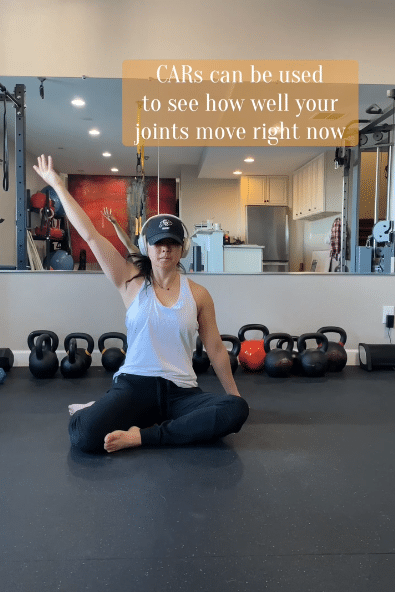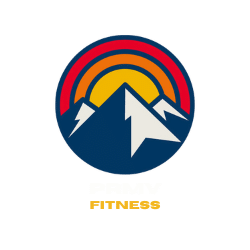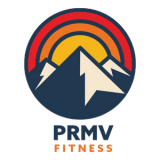
Kinstretch is defined as “a movement enhancement system that develops maximal body control, flexibility, and usable ranges of motion” by Functional Range Systems (FRS).
If you want to move with more ease, improve your flexibility, and feel better in your body, Kinstretch may be perfect for you. This in-depth guide will explain everything you need to know about Kinstretch.
We’ll cover:
Whether you’re a professional athlete or weekend gardener, Kinstretch can help you feel and perform better. Read on to learn all about this accessible movement enhancement system.
What is Kinstretch?
Kinstretch is a multi-faceted movement system designed to improve mobility, flexibility, strength, coordination, balance, and body control.
It was created by Dr. Andreo Spina and his company Functional Range Systems (FRS). It builds upon concepts from other FRS modalities like Functional Range Conditioning and Functional Range Release.
The methodology involves taking joints through full ranges of motion while strengthening the surrounding muscles. This expands movement capacity incrementally in a safe, sustainable way.
Kinstretch classes incorporate active stretching, joint mobility, stability training, and body control exercises. The result is greater ease, efficiency, and versatility of movement.
Who Can Benefit From Practicing Kinstretch?
One of the great things about Kinstretch is that it is suitable for virtually anyone of any age or activity level. Since the exercises can be easily modified, Kinstretch meets you where you’re at.
Here are some examples of individuals who can benefit from regular Kinstretch practice:
- Young athletes looking to enhance performance and prevent injury
- Middle-aged office workers seeking to relieve stiffness and discomfort
- Older adults wanting to retain mobility, independence and quality of life
- Fitness enthusiasts aiming to accelerate recovery and avoid fatigue
- Physical laborers needing to counteract repetitive motions and postures
- Chronic pain sufferers looking to improve function with less hurting
- Rehab patients wanting to regain strength and joint control after injury or surgery
- Expectant mothers seeking to make pregnancy and delivery easier on their changing bodies
It helps people of all ages move, live and feel better. It’s a sustainable, engaging practice that provides universal benefits.
How Do Kinstretch Classes Work?
Kinstretch classes generally last 60-90 minutes. The exercises target all the major joints and muscle groups in the body.
A typical class structure includes:
- Joint mobility sessions to access new ranges of motion
- Active stretching of targeted muscle groups
- Strength training in the newly gained ranges
- Movement control exercises to refine body coordination
- Assessments to increase body awareness and catch issues early
Kinstretch uses incremental loading to expand movement capacity. You progressively work muscles harder in their lengthened positions.
This stimulates lasting mechanical and neuromuscular adaptations so you can control your body effectively in expanded ranges of motion.
Sessions are structured but adaptable. Variations and modifications are always provided so each student can work at an optimal intensity.
The focus is on making incremental progress over time, not achieving advanced postures overnight. Consistent practice allows the cumulative benefits to add up.
Benefits of Regular Kinstretch Practice
Regular Kinstretch practice provides both immediate and long-term physical benefits:
Immediate Benefits:
- Greater mobility and range of motion
- Increased flexibility and tissue elasticity
- Relief of muscle soreness and joint stiffness
- Decreased discomfort during exercise or daily activities
- Enhanced energy levels and reduced fatigue
- Improved balance, coordination and movement control
Long-Term Benefits:
- Lasting increases in joint range of motion and muscle length
- Enhanced joint stabilization and resilience against injury
- Expanded strength through full ranges of motion
- More optimal posture and movement patterning
- Faster recovery from exercise due to reduced tissue loading
- Improved performance of athletic or occupational tasks
- Increased physical autonomy and independence
- Higher quality of life and less pain as we age
Kinstretch helps you move and feel better now while making lasting positive changes over time.
How Kinstretch Gives Your Body Back Its Movement Options

A key benefit of Kinstretch is that it restores your body’s full range of movement options.
We often default to certain patterns, losing access to other ways of moving. For example, someone with tight hips relies excessively on knee flexion to squat.
Kinstretch diversifies your library of movement strategies. It ensures each joint can move smoothly through its full range so no other joints have to compensate.
Having more options prevents overuse and shares the workload across multiple joints. Your body can flow seamlessly from one strategy to the next based on changing demands.
Regaining movement options helps:
- Prevent injury and degeneration
- Enhance performance, from hobbies to competitive sports
- Make daily tasks easier by moving with greater versatility
- Allow other joints to rest since no single joint bears the burden
Kinstretch gives your body the freedom to move the way it was designed to.
How Kinstretch Proactively Trains the Body to Handle Injury

Perhaps the most valuable benefit of Kinstretch is injury prevention and resilience.
It takes a proactive approach, making the body more durable through incremental stress over time.
This is like gradually preparing your muscles to run longer distances or lift heavier weights. But instead of strength, you build resilience to the demands of life and absorb forces more smoothly.
The Kinstretch approach trains your tissues to handle bigger loads before issues arise. Some key ways it does this include:
- Improving mobility to expand safe range of motion
- Enhancing control so you move tissues in optimal ways
- Strengthening joints in stretched positions
- Developing stamina to sustain demanding positions
- Promoting recovery so tissues rebound faster between stresses
With Kinstretch, it’s like you’re doing physical therapy on yourself now to bulletproof your body for the future. This prevents small strains from cascading into major injuries down the road.
You’ll also learn self-assessments to identify problems early before they do real damage. It makes your body more resilient from the microscopic level up.
What Does a Typical Kinstretch Session Involve?
A one hour session follows a structured progression to target all areas effectively. Here’s an overview:
Warm-up: Light movement generates heat and increases blood flow to tissues.
Mobility: Gentle motions take joints through full ranges of motion.
Stretching: Muscles are lengthened and loaded incrementally.
Strengthening: Muscles fire at tolerable intensities within newly gained length.
Coordination: Advanced exercises integrate strength and mobility.
Cool-down: Light stretches realign tissues.
Along the way, assessments ensure proper form and catch any problem areas early. Variations allow customized intensities.
This all-encompassing approach expands capacities exponentiality over time. You’ll be amazed how much farther you can move after a few months of regular Kinstretch sessions.
Kinstretch vs. Yoga: What’s the Difference?
People often compare Kinstretch to yoga. While both are beneficial movement practices, they have distinct differences:
- Kinstretch emphasizes controlled strength training through full range of motions. Yoga focuses more on flexibility through passive static stretching.
- Kinstretch progressively loads tissues to drive positive adaptations. Yoga follows a simpler stretch-and-hold approach.
- Kinstretch targets specific muscle groups and movements. Yoga takes a more generalized, full-body style.
- Kinstretch aims to expand movement capacity. Yoga seeks relaxation and meditation.
- Kinstretch exercises involve more dynamism and large motions. Yoga postures are held statically.
In essence, Kinstretch is active and dynamic while yoga is more passive and static. Kinstretch strengthens the connection between mind and body through movement, while yoga joins them through stillness.
One practice is not better than the other. Many people find value in both for different reasons. But it’s helpful to understand the core differences.
Is Kinstretch Right for Me?
Kinstretch is right for anyone seeking to:
- Feel more comfortable and move easier day-to-day
- Recover faster from fitness activities and sports
- Restore movement abilities after injury or chronic pain
- Prevent future injuries and manage known problem areas
- Improve posture and reverse the effects of aging
- Enhance performance in athletic, occupational or leisure tasks
- Increase mind-body awareness and attentiveness
Kinstretch meets you where you are now and helps you progress from there. Since every exercise can be modified, anyone can practice it safely.
The classes are welcoming to all ages and ability levels.
Conclusion
In summary, Kinstretch is a movement enhancement system that provides both immediate and lifelong benefits.
Kinstretch expands capacities in a gradual, holistic manner by integrating mobility, flexibility, strength and body control.
Anyone can practice Kinstretch since exercises are adaptable for different bodies. Consistent practice yields exponential rewards over time.
Hopefully this guide gave you a comprehensive overview explaining what Kinstretch is all about. Try a class and start moving with freedom today!

Join us for an online group
Kinstretch Class
✓ Beginner friendly
✓ No Equipment Needed
